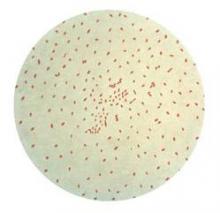Acellular pertussis vaccines prevent children from developing pertussis, but they do not prevent those children from becoming colonized with Bordetella pertussis or from transmitting the organism to others who are unvaccinated, according to a report published online Nov. 25 in Proceedings of the National Academy of Sciences.
This finding provides a plausible explanation for the resurgence of pertussis disease in the United States and in other industrialized countries, despite vaccine coverage in excess of 95%, said Dr. Jason M. Warfel of the division of bacterial, parasitic, and allergenic products, Center for Biologics Evaluation and Research, Food and Drug Administration, and his associates.
This resurgence in symptomatic pertussis was noted at approximately the same time that whole-cell vaccines were replaced with acellular vaccines in the 1990s, and it continues to the present day. There were 42,000 reported cases in the United States last year, which represents a 50-year high.
Until now, the cause of the resurgence has been uncertain. Researchers have proposed that perhaps the acellular vaccines are less effective than the whole-cell vaccines are or that the immunity they confer waned more quickly than anticipated. But it was nearly impossible to study pertussis pathogenesis in humans because of ethical considerations as well as logistical problems, and there is no animal model that adequately mimics human disease.
Dr. Warfel and his associates were able to develop a nonhuman primate model of pertussis using baboons, which closely corresponded to human pertussis disease. Using this model, they found that the acellular vaccine, whole-cell vaccine, and natural infection all induced comparably high antibody titers. This indicates that both vaccines are immunogenic and that the pertussis resurgence is not attributable to low antibody titers.
Both vaccines protected baboon subjects from developing severe symptomatic pertussis, but neither one prevented them from becoming colonized with the organism. However, baboons that received the acellular vaccine took twice as long to clear the organism from their systems as those that had received the whole-cell vaccine.
And most important, baboons that received the acellular vaccine readily transmitted B. pertussis to unvaccinated cage mates during this relatively long interval. "We hypothesized ... that [children who receive acellular pertussis vaccinations] can act as asymptomatic or mildly symptomatic carriers and contribute significantly to transmission in the [general] population," Dr. Warfel and his colleagues said (Proceed. Natl. Acad. Sci. 2013 [doi:10.1073/pnas.1314688110]).
This finding indicates that "cocooning" – vaccinating people who have contact with infants who have not completed the full series of the acellular vaccine, to prevent transmission to those infants – is unlikely to reduce the burden of pertussis in infants, they noted.
The investigators also found key differences in T-cell immune response to the two vaccines. Animals that received the whole-cell pertussis vaccine or had previously had severe pertussis disease possessed strong, pertussis-specific T helper 17 (Th17) memory and T helper 1 (Th1) memory, but those that received the acellular vaccine instead had strong, pertussis-specific Th1/Th2 memory. Th17 is a recently identified T cell that "specializes in controlling extracellular bacterial infections at mucosal surfaces through stimulating neutrophil recruitment."
"Although we have not definitively shown that Th17 cells are required for B. pertussis clearance, this correlation is consistent with the role these [Th17] cells play in fighting extracellular bacterial infections at mucosal surfaces by inducing neutrophil chemotaxis," they added.
No financial conflicts of interest were reported. This work was funded by the FDA and NIH/National Institute of Allergy and Infectious Diseases.


